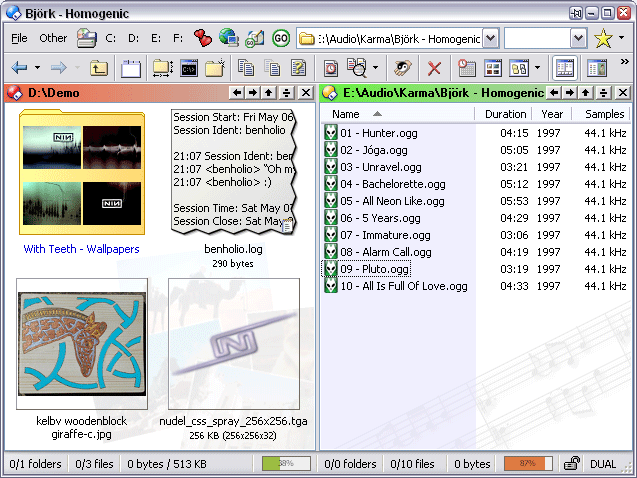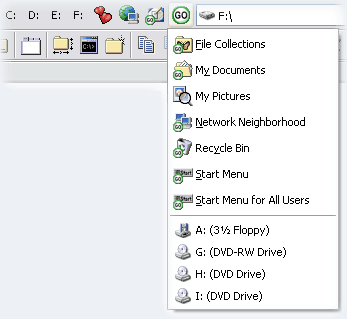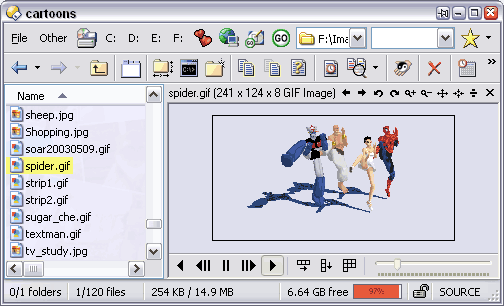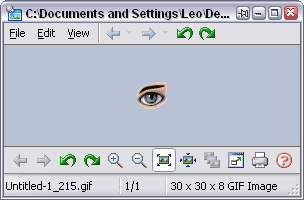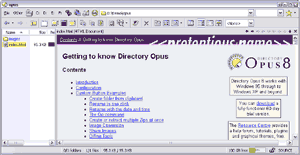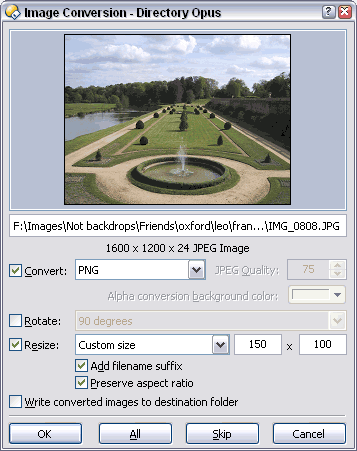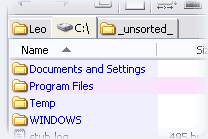 The Big Features
The Big Features
Opus has many tools, modes and, for lack of a better word, features which allow you to do things which you may not have found easy, or possible, before. This section lists some of the bigger features you'll find in Opus.
| Dual Listers | |||||||||
|---|---|---|---|---|---|---|---|---|---|
While Opus does behave like Explorer, in that you can open as many windows as you like and copy files between them, it also has a Dual Lister mode which you can toggle via a toolbar button or hotkey. Dual listers are like the more traditional file managers where you have two directories in one window. The two halves can be arranged either horizontally or vertically and there's a button to quickly switch between the two as needed. Operations with a source and destination, such as a copy or move, happen from one side to the other. You can open as many dual listers as you like and you're free to mix and match them with normal listers. Of course, you can still copy and move files between different windows via drag and drop, as you'd expect.
When Lister Docking is enabled in Preferences you can drag two single listers together to join them into a dual lister, and you can drag half of a dual lister apart to split it into two single listers. There are also buttons and hotkeys for duplicating and swapping the two sides with each other. You can create an action such as shift-double-click, or middle-mouse button double-click, which will open the selected directory in the other side of a dual lister, switching to dual mode first if required. This is really useful when managing several child directories and is often preferable to the folder tree. Speaking of folder trees, you won't see many in my screenshots, because I'm not a big fan of them, but if you feel differently then there's no need to worry. Opus gives you the choice of sharing a single tree for both sides of a dual lister or having two trees, one for each side. You can also decide at which level the tree starts and thus how much extra stuff is displayed in the tree at any given time. The options for the starting point are: Desktop, My Computer, Drives or the Current Drive only.
| |||||||||
| Drive Buttons and Go Buttons | |||||||||
|
Opus has the abilitly to put drive buttons, as well as buttons which take you to any other location, directly on the toolbar. You'll probably find it's worth putting these buttons on your toolbar for speedy navigation. It's really convenient when you're able to instantly jump to a drive or common location by clicking a button that's on the toolbar, always there and always ready.
The Drive Buttons toolbar item will generate a dynamic list of all devices in the system, automatically adding and removing them as required. For example, if a new network drive is mapped or a USB memory card is inserted it will appear in your toolbar ready to use. You can have multiple sets of drive buttons and are able to filter each by drive letters and types of device. In a dual-lister window the drive buttons will affect the Source side by default, but you can change this so that a left-click on a drive always opens it on the left and a right-click opens it on the right. | |||||||||
| Viewer Panes and Viewer Windows | |||||||||
|
Opus has a viewer pane which can be switched on whenever you need to view some files. Since the pane is docked to the window and follows the file selection it is ideal for flicking through different files without cluttering your desktop with multiple windows.
Of course, you can also open a standalone viewer window which includes a full-screen mode and slideshow functionality. Many Opus users find they no longer need a dedicated image-viewing program, but the choice is completely up to you.
As well as viewing the image formats you'd expect (and several you wouldn't), the Opus viewer can also show movies, web pages, Office documents and Flash animations. Graphics professionals may be interested to know that Opus supports transparency and alpha channels for PNG, TGA and GIF files and can display Photoshop PSD files without the need for external software, provided the files are saved with flat preview images. (Paint Shop Pro's image format is also supported.) If you're into photography you may be pleased to know that Opus supports viewing and converting the raw images produced by many higher-end digital cameras.
The viewer allows you to resize and rotate images, adjust their brightness (gamma), and print them. You can select and copy all or part of the image to the clipboard. This allows you to use Opus to crop images, and screengrabs in particular, because any image (or text) in the clipboard, whether it was put there by Opus or not, can be pasted directly into an Opus window, creating a new image (or text) file with the contents of the clipboard. Opus has a plugin system which allows third party authors to add support for further image formats and functionality. In particular, a fully-featured text editor is available as a free plugin that allows you to quickly edit the selected file in the viewer pane.
As well as providing the viewer pane display, plugins can also generate thumbnails (e.g. the Text-File Thumbnails plugin) and provide additional information columns for new file types (e.g. Ogg Vorbis and FLAC music files). | |||||||||
| Image Converter | |||||||||
|
If you want to make permanent changes to one or more images, Opus has a simple, built-in tool for doing it. You can resize and rotate images individually or in batches. The input files can be in any image format that Opus can view and the results can be written to a BMP, JPEG, GIF or PNG file. JPEG rotation is automatically lossless, where possible, avoiding the image degredation that would result from re-compression. You can overwrite the input files or instead write new ones with a specified filename suffix. This is ideal when making thumbnails for the web.
While the GUI is great for ad-hoc work, operations which you perform often can be turned into buttons that perform the desired transformations on all selected files from a single click. This is detailed later in the Custom Button Examples section. | |||||||||
| Advanced Renaming | |||||||||
|
Opus has extensive support for batch renaming. Most jobs can be handled easily using simple wildcards or find-and-replace but sometimes you need something more advanced, like regular expressions. Opus supports all three, as well as the ability to sequentially number files and modify capitalisation. When the Rename dialog is in Advanced mode you are able to store and recall presets so that you don't have to work out complex expressions each time you use them. Even better, you're given a preview, updated as you type, showing what will happen when the rename goes ahead.
Even if you already have a separate renaming tool you'll find it's far more ergonomic to have it integrated into your file manager, with renames working on the currently selected files and directories. As demonstrated in the Custom Button Examples section, you can save even more time by making buttons which execute complex rename operations in a single click without displaying the Rename dialog at all. Wildcard renaming is also available when copying, moving and duplicating files, not just when renaming them. In other words, you can copy-and-rename files on the fly, as a single operation. | |||||||||
| Flat Mode | |||||||||
|
Opus's Flat Mode will show you everything in the current directory and all subdirectories, recursively. You can choose whether the view should be grouped, like a folder tree but with files as well, or mixed, where it looks like you're viewing one big directory that has all the files in it. Flat mode even works inside Zip files and in thumbnails mode, providing a great way to see all the images in an archive at once.
| |||||||||
| Tabs | |||||||||
|
If you've used a web browser such as Firefox or Opera you're probably already convinced that tabs are good for managing multiple windows without the associated clutter. Opus supports tabs allowing you to open and flick between several directories in the same window. You can drag one or more folders onto the tab bar to open each of them in a new tab and it's also possible to create toolbar buttons and hotkeys which do the same.
Tabs can be reordered by dragged them by their icons and you can also drag tabs from one window to another. Right-clicking a tab's icon gives a menu with options to do things such as duplicate a given tab or close all tabs except the clicked one. There's a menu option for closing the selected tab but you can also middle-click it or double-click it or you can turn on the small close buttons and use them. The labels on tabs are "hot" and act like the directories they represent. You can drop files on the labels to move or copy them to the tab's directory, and right-clicking the label brings up the folder's context menu. Groups of tabs can be saved and reloaded later, allowing you to instantly recall a set of tabs you decided to keep. Tabs can appear at the top or bottom of windows and, if you're not a fan of them or just want to conserve screen space, they can be hidden altogether. We'll see more about tabs in the Custom Button Examples section. | |||||||||
| Styles | |||||||||
|
If you need to flick between several different ways of viewing the same directory then you can create toolbar buttons or hotkeys which call the appropriate commands to set the view mode, sort order and columns as desired. Alternatively, you can take advantage of the Styles system in Opus. This allows you to create and edit named styles which can change the way the current folder is viewed as well as turn on or off things such as the folder tree, viewer pane and utility panel. When invoked, styles can also set the directory which is displayed in the left or right side of a window. Styles normally appear as a set of tabs on a toolbar of their own, but you can also turn them into a standard menu or a set of toolbar buttons.
| |||||||||
| Layouts | |||||||||
|
Layouts are a bit like Styles except they can capture and recreate the configuration of multiple windows. If you have several Opus windows open you can save one or all of the windows into a named Layout. Layouts store the sizes and positions of all windows, as well as which directories they are viewing, how they are viewing them, and so on. At any time you can recall a saved layout by selecting it from a list. You can place the list anywhere you want in the toolbars and menus and it's also possible to make buttons, hotkeys and shortcuts that open a particular layout directly. It's up to you whether or not existing windows are closed when a new layout is opened.
| |||||||||
| FTP (and friends) | |||||||||
|
Opus has an advanced, integrated FTP client which also supports secure protocols such as SFTP and SSH. As far as possible, FTP directories appear and behave like any local folder and most commands work transparently. This includes your own commands which you've made to act on files: When a particular file is needed it will be downloaded to a temporary cache, then passed to the command in question.
As most people are behind some form of firewall or router these days it's essential that PASV (passive mode) and various types of proxy are supported and Opus shouldn't let you down in either case. There are numerous other options in the Preferences dialog and site-to-site FTP transfer is even supported, provided the two sites you're using allow it. | |||||||||
| Zip Folders | |||||||||
|
As you'd expect, and similar to the FTP support, Opus has internal support for Zip archives and displays them as if they were directories. Advanced functionality allows you to view thumbnails and full-size images that are in Zips. The RAR format is also supported, although it is read-only and you cannot copy files into a RAR archive. Third party developers can create "virtual filesystem" plugins which add support for additional archive formats as well the ability to view things such as the registry within Opus listers. (Registry plugin is coming soon...) |
Continue on to the next page to see more Big Features...


